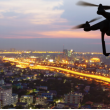Public safety is about to experience a watershed moment
The creation of the First Responder Network Authority (FirstNet) and the allocation of premium spectrum to the public-safety sector are providing the impetus for very high bandwidth communications and, for the first time, an enabling of data-rich applications.
The last 20 to 30 years have been a showcase for significant technological breakthroughs, particularly in the communications area, and they have changed our culture. It was only 25 years ago that a professor at a prominent university told me, with great excitement, that they had “just installed their first fax machine.” Fax machines soon became ubiquitous and they changed communications; they revolutionized how business was conducted. Prior to the fax machine, one dropped a letter into the mail and hoped to have a response in 2-3 weeks. Fax machines moved the turn-around time to just a few days. Soon thereafter, e-mail showed up on the scene. In today’s ultra-connected environment, one suspects a problem if an e-mail goes 3-4 hours without an answer.
The world is changing—fast—and our culture along with it. The demand for innovative technological solutions continues to grow and talented artists and engineers are responding with creative products, services, and even business models that make it all possible.
In spite of the major changes seen in virtually every area of our society, the public-safety community has largely remained untouched by the revolution. Oh, some of the dispatch consoles now have a high-definition monitor, and some of the screens on those big radios are now available in more than just black and white, but the average 12-year-old has significantly more capability in his $49 smartphone than the average policeman carries in his critical communications gear.
There are many reasons for this—security demands, durability requirements for devices, intrinsically safe specifications for devices, narrowband spectrum allocated by the FCC, relatively low volumes—one can create a long list of reasons for why the first responder hasn’t participated in the communications revolution. However, there is hope that this is about to change.
The advent of dedicated Band 14 700 MHz spectrum and the creation of FirstNet together create a historical opportunity for first responders and product providers alike. In order to maximize their participation in this technology revolution, the first responder community and the technology suppliers both will have to change.
Much of the pace of change has been driven by the rapid adoption of new technologies by very broad segments of society around the world. This has created huge markets that attract many small and large companies hoping to capitalize on an extensive customer base, which makes it possible to incur heavy development costs.
Many factors have contributed to the slow pace of technology infusion into the public-safety market. For instance, the channel bandwidth allocated by the FCC (12.5 kHz and 25 kHz) has created physical constraints that impose data-rate limitations. But perhaps more important is the size of the market itself and its unique requirements that have evolved over the years. Undoubtedly, first responders have demands that far exceed those of the average teenager and nearly all consumers. However, when unique requirements are placed on devices, or on applications, they begin to dissect the market into smaller sub-segments that greatly reduce the volume possibilities. When markets get smaller, and the possible customer base starts to shrink, the attractiveness to the creative risk-takers driving the technological train starts to diminish. It becomes much harder to justify a large research-and-development investment with a limited market size.
To put it in perspective, the worldwide smartphone market exceeds 1 billion active users, with more than 100 million in the U.S. alone. Contrast that with a first-responder market, worldwide, of about 30 million, and a U.S. market ranging from 3 million-10 million (depending on who is included.) It’s easy to see where most of the research effort is being focused.










